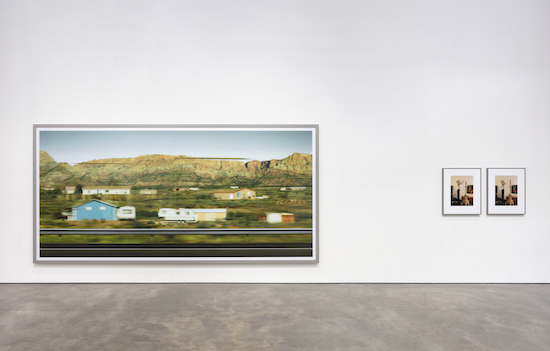All images: Installation view, Andrew Gursky, Sprüth Magers, Berlin. Copyright Andreas Gursky / VG Bild-Kunst, Bonn, 2020. Courtesy Sprüth Magers
The photographs are monumental in size of course and full of fine detail but… what’s this? A pinky white anatomical shape that could be a human body lying on a bed of straw. The creature has its snout dug snugly into the soft bedding; in the background enormous bales are stacked in a neat sculptural row like a Donald Judd series. There’s no bucolic loveliness here as with Monet’s haystacks, these organic forms have the heft of one of Richard Serra’s public metalworks. This is Pigs (2020), an image of comfort, of warmth, and spacial plenitude that stands in marked contrast to Gursky’s other visions of cramped constructions for humans. Robert Wyatt would no doubt approve; these porkers live in some style.
Gursky’s critical take on modernist German architecture is seen most explicitly with the stunningly mute Bauhaus (2020). A massive white metallic windowless building is topped by a red sign advertising this Teutonic equivalent of B&Q, a hardware hypermarket that looks coldly uninviting. The angles of the rectangular box-like construction are shot receding into the distance and immediately recalls Ed Ruscha’s iconic Standard Station (1966). Ruscha is referenced elsewhere in the show with Politik II (2020), where thirteen Bundestag politicians gas under a giant Ruscha clock that Gursky has sampled/superimposed. There’s a sarky allusion to the twelve apostles surrounding Angela Merkel (particularly Jesuitical is the long haired Green Party representative, Anton Hofreiter), but the underlying implication of the work is that time is against these guys. This really is the last supper.
Rhine III (2018) underlines the message of doom and imminent environmental catastrophe. The earlier version, Rhine II, from 1999, is a lush green and grey sequence of horizontal bands that deliberately reminds us of peak Abstract Expressionist sublime, the likes of Barnett Newman and his portentous Zip paintings. Rhine II remains the most expensive photograph ever sold. The 2018 update has none of the earlier image’s expansive bosky luxuriousness. The land is as burnt and raw, as scuffed and tatty as an abandoned bed of old straw. But what is to be done? Gursky implies elsewhere that leaders, as with Rückblick (2015), where we see the backs of four German chancellors contemplating Newman’s Vir Heroicus Sublimis (1959-51), are helpless and useless in the face of the inevitable.
Even some of our traditional escape routes are being blocked. Cruise (2020) is a side on view of a ridiculously large ship in dry dock called the Norwegian Rhapsody. Imagine the Pompidou Centre converted into floating flats, a marine Byker Grove. But who’s going to book a holiday these days in such mobile incubators for Norovirus and COVID-19? Gursky’s image overwhelms and recalls Joseph Addison’s take on the Alps: an “agreeable kind of horror”.

People are back hiding in their cars again and Gursky revisits Kantian notions of the sublime and ‘boundlessness’ with his manipulated pictures taken with an iPhone on the road. With Utah (2017), the horizontal bars of colour blur the intermittent housing: this is what we see at high speed, bands of brown and green, an occasional glimpse of humanity. This is travel as depersonalisation, what we see becomes derealised; travel becomes “in trance as mission” as Simple Minds have it. This applies equally to the more urban landscape of Tokyo (2017) with its ticky tacky boxes stripped of inhabitants. If you cannot read Japanese a sign in English advertising Niki Golf holds our attention momentarily and is soon gone.
Who or what might help us get through the mess we’re in? Gursky looks at paragons of innovation and finance. Apple (2020) is a vision of the company HQ, designed by Foster and Partners, all silvery sheen and glimmer where all that’s solid really does appear to melt into air. Another sequence of photographs features the Hong Kong Shanghai Bank (all 2020). Here Gursky has played with the projected animations common to skyscrapers in the new East. In one we see a mass of multicoloured umbrellas referencing the democracy protest movement of 2014, a rare yellow brolly is decorated with an overly optimistic Smiley face. In another, Gursky has superimposed a sequence of words, Jenny Holzer style: ‘vaccine’, ‘Amazon’ and ‘Babel’ leap out.
Oddly and lastly it’s a work called A und E (2020) that reassures, initials most of us want to avoid right now. This is a modestly sized portrait, a side shot of Gursky’s partner holding a new born baby to her shoulder. The bairn has a fine head of hair and sleeps soundly. Larkin’s words, now clichéd, say that what will survive of us is love: right now we really need to hear and believe in that.
Andreas Gursky is at Sprüth Magers, Berlin, until 14 November 2020


